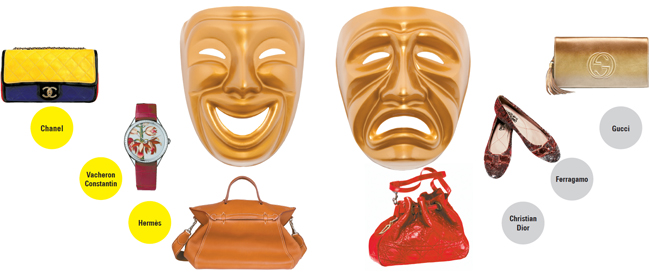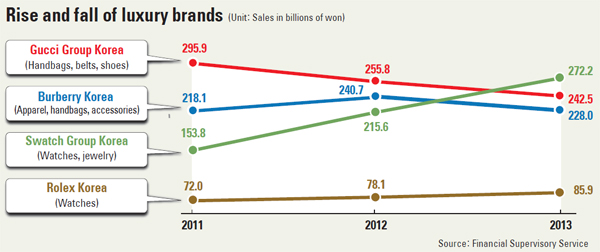Middle-class deserts some favorite fancy brands

Over time, however, Park’s preferences started to change.
Park is a bride-to-be with her wedding coming up in May. And recently she and her fiance visited a department store to look for wedding gifts they could give to each other. Rather than giving and receiving a variety of presents, which is the usual custom in Korea, the couple decided to each pick one item each.
Her fiance said he really wanted an IWC Schaffhausen Portofino watch. Park zeroed in on a vintage handbag - the Chanel 2.55.
“My fiance and I invested after considering the future value of the products,” Park said. “Rather than buying products from Ferragamo or Gucci, which are not as scarce as they were in the past, we thought it would be wise to buy a luxury watch and a Chanel bag.”
A luxury watch never loses value and can be used for decades, Park explained, while the price of Chanel bags just keeps going up.
Trends in Korea’s luxury industry are changing. So-called first-generation luxury brands like Gucci, Ferragamo and Burberry, which ruled the market in the past, are losing some of their luster. Sales in Korea have gone down, and some brands have even closed branches in department stores.
On the other hand, luxury items like watches and jewelry from unique brands are emerging as popular picks by consumers.
Recently, Ferragamo closed its store in Galleria’s luxury hall when the department store operated by Hanwha Galleria, an affiliate of Hanwha Group, underwent redecoration.

Industry sources, however, said the store closed because its business was poor.
According to data from the Financial Supervisory Service, sales of Ferragamo Korea in 2011 reached 97.2 billion won ($93.6 million), while the figure was 98.4 billion won in the following year. Last year, sales made it to 111.9 billion won. However, operating profit over the past two years halved from 21 billion won to 10.7 billion won.
Gucci Group Korea is in the same boat.
Last month, Karim Fettous became the head of Gucci Group Korea as part of efforts to improve the brand’s performance, but change is slow in coming. Fettous was formerly with Louis Vuitton.
Gucci Group Korea’s sales last year were 242.5 billion won, compared with 255.8 billion won in 2012 and 295.9 billion won in 2011. Operating profit dwindled from 46 billion won in 2011 to 28.3 billion won last year.
Burberry Korea is also struggling. Although sales of the British brand in the local market have been about 200 billion won annually for the past three years, operating profit has gone from 42.8 billion won in 2012 to 21 billion won in 2013.
Industry insiders say the difficulties of the brands mirror the struggles of the middle class. They say that top-tier luxury brands like Hermes and Chanel, which are popular with the superrich, have not been affected by the economic slowdown, but brands like Gucci and Ferragamo are more reliant on a middle-class customer base.
According to a local department store, sales of Prada, which is in the Gucci price range, dropped 15 percent year-on-year in 2013. But sales of super-expensive brands like Hermes and Chanel are robust. Sales of Hermes products jumped 20.3 percent in 2013, and Chanel’s were up 21.8 percent.
“Sales for Hermes, which usually sells handbags for more than 10 million won, keep rising regardless of economic conditions,” said an official from another department store. “The same is true for Chanel, which sells handbags priced between 5 million and 10 million won.
“But for brands that sell bags between 2 million won to 5 million won, sales differ largely based on consumers’ financial circumstances.”
Some analysts note that with a growing number of Koreans buying imported products online, and with retail channels being diversified, the value of traditional brand items has fallen.
“As for Hermes, it has been pursuing a high-end marketing strategy,” said an official from a department store. “For example, customers are qualified to buy its Birkin bag if they have a buying track record of more than 20 million won in purchases previously.”
Some industry insiders say Korea’s luxury brand industry has matured and that consumers now look for more diversity. Consumers so far purchased mainly miscellaneous luxury brand items like handbags, shoes and belts, but that trend is gradually changing and consumers are now interested in high-priced watches and jewelry.
The operating profits of luxury watch and jewelry brands have expanded in recent years. Sales for Richemont Korea, the local unit of Richemont that owns several luxury brands like IWC, Vacheron Constantin, Van Cleef & Arpels and Cartier, nearly doubled from 243.2 billion won in 2012 to 413.9 billion won last year.
“The luxury market grows in four stages - beauty, miscellaneous goods, apparel and watches and jewelry,” said an official from Cartier.
Sales of Swatch Group Korea, the owner of brands like Omega and Tissot, reached 215.6 billion won last year, up 40.1 percent compared to the previous year. Operating profit also jumped 208.1 percent over the same period to 22.1 billion won. Rolex Korea also saw sales jump 10 percent last year from the year before to 85.9 billion won, while operating profit went up 23.3 percent to 9.1 billion won.
BY CHAE YOON-KYUNG [angie@joongang.co.kr]










with the Korea JoongAng Daily
To write comments, please log in to one of the accounts.
Standards Board Policy (0/250자)